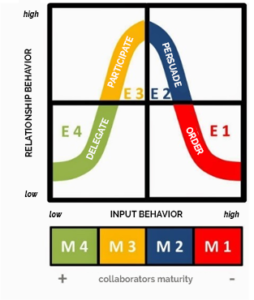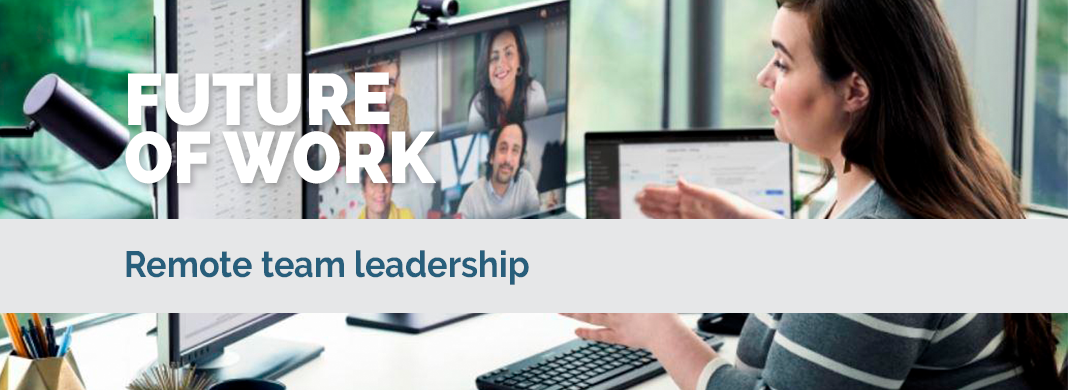Best practices for remote team leadership
According to Paul Hersey and Kenneth H. Blanchard’s SITUATION LEADERSHIP Theory, as a subordinate’s maturity level rises in compliance with an activity, his supervisor reduces the specifications about the job (work behavior) and focuses on the development of his subordinate to take on new challenges (relationship behavior). Maturity is not only about the task, but the subordinate is psychologically better prepared to perform autonomously.

The Situational Leadership Theory defines maturity as the ability to set high but attainable goals (motivation, achievement), and the willingness and ability to assume responsibility, and education and/or experience of an individual or a group.
When we learned this and visualized it in the Situational Leadership chart, we understood that when the context changed, many people regressed to a previous level of maturity, and required new specifications about their work.
This was sometimes due to profound changes in the work team (colleagues who were key references in the task left) or when facing promotions (I am facing new or different challenges).
Today we are living through a global change that was unthinkable and for which we were not so prepared. What we imagined from our FUTURE OF WORK agenda as a job to be accelerated in the next two to three years, has translated into the challenge of “right now” to be well operational in two to three weeks. The challenge of remote work for all our collaborators, clients, partners and suppliers radically changes our leadership model.
The team today is spatially dispersed. Everyone interconnects from “their place”, in the middle of their family or their loneliness. There are both background voices in one case, and the need for proximity in the other.
We interact both with those who are completely autonomous and with many who require more immediate supervision and containment, and both must be successful in the distributed work model.
The old attributes (office location, clothing, where everyone sits in the meeting, etc.) are gone, and the reality creates the challenge of rethinking how we will carry out leadership.
Let’s look at some keys from two perspectives: that of the Leader and that of the Collaborator.
From the Leader’s perspective
CONTEXT: estimated: the old attributes are gone (location of the offices, clothes, where everyone sits in the meeting, etc.), we can no longer distinguish people by looking at them, we will have hours between contact and contact. Here are some useful recommendations with two objectives:
HAVING PRODUCTIVE DAYS
- Do we know the Home working situation of each collaborator to help them manage in that context?
- Do we define what each one should do?
- Do we imagine what the typical day for each role is like and did we discuss it with our people, to give them tips on how to get to a deliverable by the end of the day?
- Do we take advantage of leaders and intermediate referents to be closer to those who need more supervision?
- Are we clear in our expectations towards our collaborators (micro-management)? Remotely, the grays are complicated?
- If we do not know detailed know-how who could explain it to them?
- Do we set individual and group end-of-day goals and communicate them properly at the beginning?
- Could we make a dashboard with those goals and use it as a check list for our team?
- Did we review our agendas and our collaborators’ agendas, to understand from their order if they know how to organize their day?
MAINTAIN PROXIMITY AND INTEGRATED WORK TEAMS
- Are we establishing recurrent points of contact for the team to interact, with spaces to express themselves? Do we listen to them?
- Do we hold 1-to-1 meetings with people?
- Were we able to incorporate the corridor talks and personal stimulation into the home working?
- Are we only on the “to do list”, or do we generate spaces for celebration and encouragement of achievement?
- Do we give the same focus to stimulating the activity as to thanking for the contribution made? Is there digital clapping?
- Do we clearly state that actions and behaviours are non-negotiable? Response times, not strictly adhering to schedules, not being careful with hurtful comments, not noticing risks, etc.
From the Collaborator’s perspective
CONTEXT: dear: the job is a two-way street! Don’t assume that your supervisor knows everything about you and the context in which you work if you don’t ask him for help. The situation is new and requires that we all work together to keep UP in operation. You will grow in organization and autonomy because the team needs it.
HAVE PRODUCTIVE DAYS
If I live at home with the others:
- have I managed to adjust my schedule so that I can integrate mentally and emotionally with the task, as if I were at the office?
- Was I able to divide the collaborative activities and schedule them, since I participate in them together with others and they require a quieter environment?
- Do I have the tranquillity and concentration to work on those tasks that I do offline?
If I do not live with others:
- Can I hold my attention without distractions?
- Do I have a very intense agenda to sustain my concentration throughout the day?
For everyone:
- Have I established meeting points during the day with colleagues to maintain an intense work relationship and to help me with doubts and validation of my work?
- If I have shared tasks in agreement with my peers, an agenda where we both can?
- When I talk to my supervisor, do I have a pre-arranged agenda of doubts and do I let him know a little in advance so that he can help me resolve it and give me more autonomy?
Leadership is more than ever situational. Our teams require us. We have to put ourselves in the context of each collaborator’s time and place. To be able to understand how to achieve our objectives and make each of them perceive that we care and that their contribution is relevant to the moment.
These are moments of personal proximity. Moments to control our interactions. When we express ourselves, our objective is that the videoconferences leave our collaborators clear, committed and motivated to do what we agreed… or not.
> READ MORE: Una buena, Smartworking llegó para quedarse.
> READ MORE: Aplicar SMART para la gestión de crisis.

